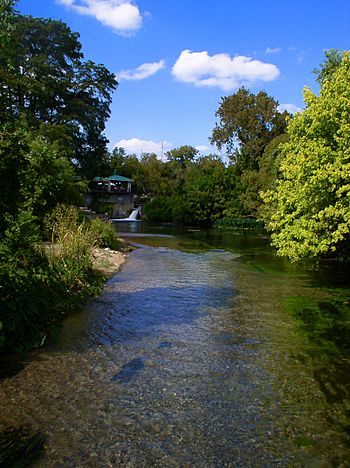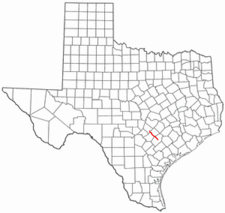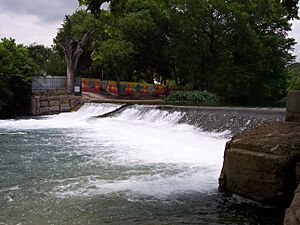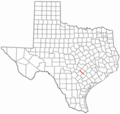San Marcos River facts for kids
Quick facts for kids San Marcos River |
|
|---|---|

The San Marcos River downstream from the San Marcos Springs
|
|

Map of the San Marcos River
|
|
| Other name(s) | Río San Marcos |
| Country | United States |
| State | Texas |
| Physical characteristics | |
| Main source | San Marcos Springs San Marcos, Texas, U.S. 575 ft (175 m) |
| River mouth | Guadalupe River Gonzales County, Texas, U.S. |
| Length | 75 mi (121 km) |
| Basin features | |
| Basin size | 522 sq mi (1,350 km2) |
The San Marcos River is a beautiful river in Texas, USA. It starts from the San Marcos Springs in San Marcos, Texas. These springs are very special. They are home to many rare plants and animals. Some of these species are even endangered.
People love to visit the San Marcos River. It is a popular spot for fun activities. You can go tubing, canoeing, swimming, and fishing here.
Contents
River's Journey: Where Does It Flow?
The San Marcos River begins at the San Marcos Springs. Water comes up from the Edwards Aquifer into a place called Spring Lake. This area is very important. It has a delicate ecosystem with many rare species. Because of this, access to some parts of the river's start is limited.
The upper part of the river flows through the city of San Marcos. This section is a favorite for recreation. After about four miles, the Blanco River joins it. The San Marcos River then flows past Luling and Palmetto State Park. Finally, near Gonzales, it flows into the Guadalupe River. The San Marcos River travels a total of 75 miles (121 km). This journey is also the first part of the famous Texas Water Safari race.
River's Past: A Look Back in Time
The history of the San Marcos River is quite interesting. It might have been found by an explorer named Alonso de León in 1689. But some experts think he might have found other rivers instead. Over time, people started calling the first big river past the Guadalupe the San Marcos.
In 1808, the Spanish built a settlement called San Marcos de Neve. It was just south of where San Marcos is today. They were friendly with the Tonkawa Native Americans. But another group, the Comanche tribe, caused them to leave in 1812. The river has also seen big floods. Major floods happened in 1998 and 2015.
Exciting Events on the River
San Marcos is home to many exciting events held on the river.
The Texas Water Safari Race
The Texas Water Safari is a very famous event. It has been held every year since 1963. In this race, canoes are powered only by people. The race uses both the San Marcos River and the Guadalupe River. It stretches from Aquarena Springs in San Marcos all the way to Seadrift, Texas. That's a huge distance of 260 miles!
This event includes several parts. There's an information meeting, a preliminary race, and the main safari race. Racers must bring enough food and supplies to last the whole journey. The Texas Water Safari is known as the "World's Toughest Boat Race." It happens every year on the second Saturday of June.
San Marcos River Clean-Up Day
Another important event is the annual San Marcos River Clean-Up. This is an organized effort to clean the entire river in the spring. Volunteers can help in different ways. Some use canoes to pick up trash and debris from the river. Others help cook food for a special thank-you dinner for all the volunteers.
Tom Goynes, who leads the Texas River Protection Association, organizes the clean-up every year. It usually takes place on the first Saturday of March. It's a great way to help keep the river healthy and beautiful.
Amazing River Wildlife
The San Marcos River is home to many different kinds of wildlife. Some of these species are endangered. This means their numbers are very low, or they have lost their natural homes.
Endangered Animals
- Texas blind salamander: This unique salamander is only found in certain parts of the San Marcos River and the Edwards Aquifer.
- San Marcos salamander: Like the Texas blind salamander, this species is also endangered and lives in the river.
- Fountain darter: This small fish has a mottled brown body with dark spots. These markings help it blend in with the river bottom. Its population is growing in the San Marcos River.
- San Marcos gambusia: This fish has dark stripes along its body. Its population is unknown, and some even think it might be extinct. Both the fountain darter and San Marcos gambusia need clear, clean water that flows constantly and has a steady temperature.
Endangered Plants
- Texas wild rice: This is an endangered plant that only grows in the San Marcos River. There are only about 230 clumps left in two different areas of the river. One group of these plants is grown on the Texas State University campus.
The San Marcos River is one of the most diverse water environments in the Southwestern United States. Because of its special wildlife, the United States Fish and Wildlife Service and Texas Parks and Wildlife Department have named the San Marcos Springs and Spring Lake "critical habitat." This means these areas are very important for the survival of endangered plants and animals. Special efforts are made to manage and protect them.
Protecting the River: Restoration Efforts
A large part of the San Marcos River is protected. This is thanks to the Edwards Aquifer habitat conservation plan. This plan was created in 2006. It is an agreement between several Texas cities. These cities use the river's resources. The plan helps manage the water and habitats of the Comal and San Marcos springs.
This plan helps in many ways:
- It controls non-native species (plants or animals not originally from the area).
- It helps keep native species stable.
- It removes extra sediment (dirt and sand) from the river.
- It works to reduce pollution.
- It protects the river's natural flow.
A big part of the restoration work focuses on the San Marcos River banks. Non-native plants are removed, and new native plants are put in their place. Also, six new places were planned for people to get in and out of the water. This helps protect the river banks from damage. The city planned to spend about $1 million on these efforts. The goal is to make the river a better home for wildlife and improve it for recreation.
Images for kids
See also
 In Spanish: Río San Marcos (Estados Unidos) para niños
In Spanish: Río San Marcos (Estados Unidos) para niños




